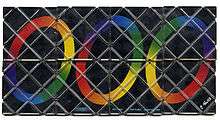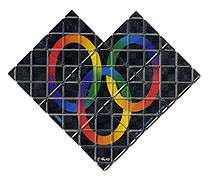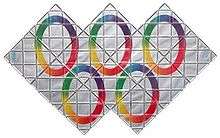Rubik's Magic
Rubik's Magic, like Rubik's Cube, is a mechanical puzzle invented by Ernő Rubik and first manufactured by Matchbox in the mid-1980s.


The puzzle consists of eight black square tiles (changed to red squares with goldish rings in 1997) arranged in a 2 × 4 rectangle; diagonal grooves on the tiles hold wires that connect them, allowing them to be folded onto each other and unfolded again in two perpendicular directions (assuming that no other connections restrict the movement) in a manner similar to a Jacob's Ladder toy. The front side of the puzzle shows, in the initial state, three separate, rainbow-coloured rings; the back side consists of a scrambled picture of three interconnected rings. The goal of the game is to fold the puzzle into a heart-like shape and unscramble the picture on the back side, thus interconnecting the rings.
Numerous ways to accomplish this exist, and experienced players can transform the puzzle from its initial into the solved state in less than 2 seconds.[1] Other challenges for Rubik's Magic include reproducing given shapes (which are often three-dimensional), sometimes with certain tiles required to be in certain positions and/or orientations.
History
Rubik's Magic was first manufactured by Matchbox in 1986. Professor Rubik holds both a Hungarian patent (HU 1211/85, issued 19 March 1985) and a US patent (US 4,685,680, issued 11 August 1987) on the mechanism of Rubik's Magic.
In 1987, Rubik's Magic: Master Edition was published by Matchbox; it consisted of 12 silver tiles arranged in a 2 × 6 rectangle, showing 5 interlinked rings that had to be unlinked by transforming the puzzle into a shape reminiscent of a W. Around the same time, Matchbox also produced Rubik's Magic Create the Cube,[2] a "Level Two" version of Rubik's Magic, in which the puzzle is solved when folded into a cube with a base of two tiles, and the tile colors match at the corners of the cube.[3] It did not have as wide a release, and is rare to find.
In 1996, the original version of Rubik's Magic was re-released by Oddzon, this time with yellow rings on a red background; other versions (for example, a variant of the original with silver tiles instead of black ones) were also produced, and there also was a strategy game based on Rubik's Magic. An unlicensed 2 × 8 version was also produced, with spheres printed on its tiles instead of rings. Custom versions as large as 2 × 12 have been built using kits available from Oddzon.
Details

It can be seen that the total number of 2 × 4 rectangles that can possibly be created using Rubik's Magic is only thirty-two; these can be created from eight distinct chains. The easiest way to classify chains is by the means of the middle tile of the puzzle's finished form (the only tile that has segments of all three rings) and the tile next to it featuring a yellow/orange ring segment (the indicator tile).
Every chain either has the middle tile on the outside (O) or the inside (I) of the chain; if it is arranged so that the indicator tile is to the right of the middle tile, then the position of the ring segment on the indicator tile can either be the upper left (UL), upper right (UR), lower left (LL), or lower right (LR) corner. The position and orientation of the remaining tiles are then determined by the middle and indicator tiles, and eight distinct chains (OUL to ILR) are obtained, although the naming convention is not standardized.
Similarly, the 2 × 4 rectangle forms of them can be categorized. Each of these forms has exactly one chain associated with it, and each chain yields four different rectangle forms, depending on the position of the edge where it is folded with regard to the middle tile. By concatenating one of the numbers 0, 1, 2, or 3 to the chain's name, depending on whether the number of tiles to the right of the middle tile before the folding edge, a categorization of the rectangle forms is obtained. The starting position, for example, is rectangle form OUR2. The cube now is rainbow and has silver rings. A game rule for this one is you can match the silver rings and color squares, which can make it more complicated. A similar classification can also be obtained for the heart-shaped forms of the puzzle, of which 64 exist.
Analysis
One question when analyzing Rubik's Magic concerns its state space: What is the set of configurations that can be reached from the initial state? This question is harder to answer than for Rubik's Cube, because the set of operations on Rubik's Magic does not form a mathematical group.
The basic operation (move) consists of transferring a hinge between two tiles T1 and T2, from one pair of edges (E11 of T1 and E21 on T2) to another pair E12 and E22. Here, edges E11 and E12 are adjacent on tile T1, and so are edges E21 and E22 on tile T2 but in opposite order. See the figure below for an example, where E11 is the East edge of the yellow tile, E21 is the West edge of the red tile, and both E21 and E22 are the North edges.

In order to carry out such a move, the hinge being moved cannot cross another hinge. Thus, the two hinges on a tile can take up one of five relative positions (see figure below). The positions are encoded as a number in the range from -2 to +2, called the wrap. The difference between wrap -2 and wrap +2 is the order of the neighboring tiles (which one is on top). The total wrap of a configuration is calculated as the alternating sum of the wraps of the individual tiles in the chain.
The total wrap is invariant under a move. Thus, one can calculate the number of theoretically possible shapes of the chain (disregarding the patterns on the individual tiles) as 1351.[4]

Furthermore, the other tiles in the chain will have to move through space appropriately to allow the folding and unfolding needed to carry out a move. This limits the practically reachable number of configurations further. That number also depends on how much stretching of the wires you tolerate.
Records
The world record for a single solve of the Magic is 0.69 seconds, set by Yuxuan Wang. Yuxuan Wang also holds the record for an average of five solves - 0.76 seconds set at the Beijing Summer Open 2011 competition.[5] Due to the World Cube Association no longer recognizing Rubik's Magic as an official event as of 2012, Yuxuan Wang holds the permanent world record for this puzzle.
Rubik's Magic: Master Edition


Rubik's Magic: Master Edition (most commonly known as Master Magic) was manufactured by Matchbox in 1987. It is a modification from the Rubik's Magic, with 12 tiles instead of the original's 8. The puzzle has 12 panels interconnected with nylon wires in a 2 × 6 rectangular shape, measuring approximately 4.25 inches (10.5 cm) by 13 inches (32 cm). The goal of the game is the same as for Rubik's Magic, which is to fold the puzzle from a 2 × 6 rectangular shape into a W-like shape with a certain tiles arrangement. Initially, the front side shows a set of 5 linked rings. Once solved, the puzzle takes the shape of the letter W, and shows 5 unlinked rings on the back side of the previous initial state.[6]
As a puzzle, the Master Edition is actually simpler than the original Rubik's Magic. With more hinges, the player can work on one part, mostly ignoring the other parts. The minimal solution involves 16 quarter-turn moves.[7] There are multiple solutions.[6] The puzzle was an official World Cube Association (WCA) event from 2003-2012.[8]
See also
- Pocket Cube
- Rubik's Cube
- Rubik's Revenge
- Professor's Cube
- V-Cube 6
- V-Cube 7
- V-Cube 8
- Combination puzzles
- Mechanical puzzles
- Jacob's ladder (toy)
References
- Official World Rankings
- Rubik's Create The Cube at TwistyPuzzles.com, retrieved May 2, 2007
- Rubik's Magic: Create the Cube at Jaap's Puzzle Page, retrieved May 2, 2007
- Verhoeff, Tom (1987). "Magic and Is Nho Magic" (PDF). Cubism For Fun (15): 24–31. Retrieved 2014-08-27.
- World Cube Association Official Results - Rubik's Magic
- "Jaap's Puzzle Page: Master Magic". Retrieved 2010-06-01.
- Verhoeff, Tom (1987). "Minimal Solutions for the 12-Magic" (PDF). Cubism For Fun (16): 12–13. Retrieved 2014-08-27.
- "WCA Competitions". WCA. 2010. Retrieved 2010-06-01.
External links
- Pictures of Rubik's Magic in various configurations
- Detailed description and analysis
- List of all 1351 theoretically possible shapes (Legend: = stands for wrap -2; - stands for wrap -1; 0 stands for wrap 0; + stands for wrap +1; # stands for wrap +2)
- Categorising folding plate puzzles (plus tips)
- New themes and different (solving-wise) mechanical types of folding plate puzzles
